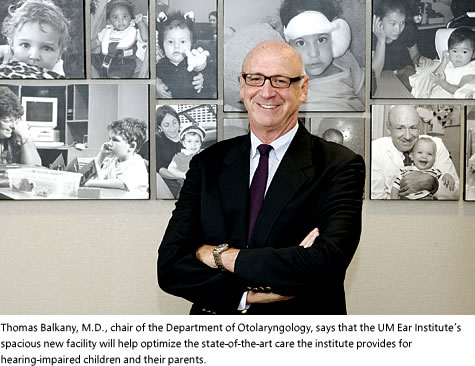Optimizing Cochlear Care
Ear Institute Opens
in Clinical Research Building
With the help of a $5 million Miami-Dade County bond approved by voters, the University of Miami Ear Institute, part of University of Miami Health System (UHealth), has a new home in the Clinical Research Building, where faculty will see both insured and underserved patients and will continue their groundbreaking research on hearing loss.

Housed within the nationally ranked Department of Otolaryngology, the UM Ear Institute is one of the busiest centers in the United States. The new 20,000-square-foot facility quadruples the amount of space the facility has at its disposal, which should allow it to make more resources available to hearing-impaired children and their parents.
“This is a unique, high-tech facility that provides our patients with diagnostic and treatment capabilities that are unsurpassed anywhere,” says Thomas Balkany, M.D., Hotchkiss Professor and chair, Department of Otolaryngology, and professor of neurological surgery and pediatrics. “The Ear Institute is also designed to optimize clinical research and train ENT professionals from around the world.” Fred Telischi, M.D., was appointed director of the Ear Institute in 2000.
The institute’s Cochlear Implant Center is the busiest and most advanced in Florida and includes an auditory verbal therapy program to help children learn to listen with their cochlear implants. Among other high-tech additions, the new clinic features a highly advanced Hearing Aid Center, Computerized Dizziness and Balance Center, a Tinnitus Treatment Center, and a state-of-the-art Audiology Diagnostic Center. The examination rooms are equipped with microscopes and flat-screen monitors that allow patients to observe the interior of their ears, noses, and throats, as well as minor surgical procedures.
Years in the making, the Cochlear Implant Center has come to fruition under the leadership of Miller School Dean Pascal J. Goldschmidt, M.D., with support from the Jackson Health System and the Miami-Dade County Board of County Commissioners—especially Commissioner Sally A. Heyman—as well as advocates such as Judge Beth Bloom and Lyle Stern, the parents of a cochlear implant patient.
In the UM Ear Institute’s waiting room, a 14-foot-wide black-and-white photo collage tells the story of thousands of patients who have had their hearing restored at the institute. In one photo, Balkany holds toddler Justin Fieler, the institute’s 1,000th cochlear implant patient.
The institute had been a dream of Balkany’s since he arrived at UM in 1990. “We see patients with hearing loss, dizziness, ringing in the ears, tumors of the ear, and other disorders,” says Balkany. “As a part of an academic medical center, we are oriented to develop new information and new technology to perform clinical trials and to teach physicians from around the world. This approach provides our community with access to leading-edge research and treatment.”
Ongoing research focuses on delivery of pharmaceutical agents to the cochlea to preserve hearing, identification of the genes that cause deafness, and restoration of normal gene function. Future research will explore the use of stem cells to restore hearing.